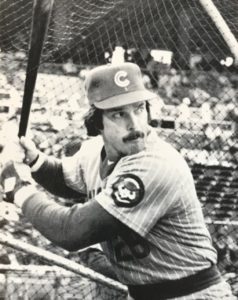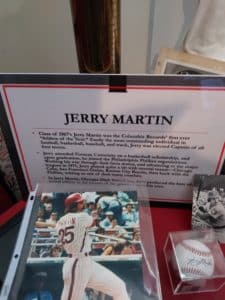Jerry Martin grew up around the winning sports traditions of Olympia Mills. He graduated from Olympia High school in the late 1960s. He went on to play in the major leagues and make a career out of a game that most just enjoy as a past time. Jerry started in the big leagues with the Philadelphia Phillies, but over his ten plus year career he went on to play for the Cubs, Giants, Royals and Mets. He then went on to coach for various teams and share the buses with the young, talented boys in between second and third tier ball parks across the country. At 70 years of age, Jerry still cuts an envious, athletic figure as he sits down to talk about his memories of Olympia from the late 1950s on.

Jerry Martin of Olympia while playing for the Chicago Cubs.
“The smell I remember most vividly is the creosote of the railroad timbers as we crossed the tracks” to play in Clevart’s pasture. We would “play ball around the cows and around the cow droppings.” It was a field that was located next to the Capital City Park baseball stadium off of Assembly Street. The same one built in 1927 by the Hall of Fame owner of the Pittsburgh Pirates, Barney Dreyfuss.
“We played all the time. We played baseball, football, track, and basketball. My favorite sport was basketball. Baseball really was just something to do to play during that season.”
That love of sports and competition, in general, served him well. He received scholarships for basketball and he went on to play for Furman, winning the MVP award for the Southern Conference in 1971. He would also play baseball for the Paladins and have a stint as a long jumper on the track team during his senior year. When the Phillies offered him a contract, baseball became his calling.
He grew up off of Ferguson Street, at his grandmother’s house, and then moved around the corner onto Whaley St. His mother worked for a time in the nearby mill, while his dad worked the railroad and played professional baseball on the side. “I am proud to say I come from good genes. My dad was a pretty dag-gone good athlete and so was my mother… She was a heckuva basketball player… It was kind of a natural thing for me to do (to excel in sports).” That and the coaches, “like coach Giles and coach George Martin (my cousin), they made sure I was out there playing… It wasn’t like I had much of a choice,” he says with a smile and a hearty laugh. “I loved every minute of it and I had a great time!”

Jerry Martin shadowbox at the Olympia Museum
Jerry started playing little league ball in Pacific Park, named after the Pacific Mills Company that owned Olympia Mills. He described the atmosphere in Olympia as being tight knit where people took care of each other. “I remember as a kid, all of us kids—not just me, when school was out, we were basically barefooted till school got back in.” “Seriously, our only mode of transportation was our two feet.” It was a time of invented games like “Hit the Can” and “Roller Bat.” “We played every chance we could get, and we wouldn’t just play baseball. We would make bows and arrows out of tree branches from the pasture. It was fun. It kept us busy.” Pacific Park always had something going. They had the baseball field and basketball courts. They had a spray pool for the summer heat and “we found things to do in the winter time as well.”
As Jerry’s memories spill out during the interview, he fills the listener’s mind with visions of an almost idyllic time of carefree bliss in and around Olympia Mills during the 1950s and 1960s. One can almost picture his crew of about a dozen neighborhood kids running from street to street, jumping creeks, railroad ties, playing ball and just being boys. For Jerry it was a great time where he matured and blossomed into a world class athlete playing on the biggest stages of his sport. For those in the know, Jerry Martin was a natural by-product of the sports environment of Olympia Mills.
Eric Barnes is a retired member of law enforcement, a book author and writes for The Standard.
Please visit our sponsors and donate to support The Standard on this page.



 RSS - Posts
RSS - Posts